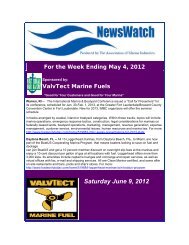Download a copy of AMI's Clean Marina best management practices ...
Download a copy of AMI's Clean Marina best management practices ...
Download a copy of AMI's Clean Marina best management practices ...
You also want an ePaper? Increase the reach of your titles
YUMPU automatically turns print PDFs into web optimized ePapers that Google loves.
• Plug scuppers to contain dust and debris.<br />
• Incorporate guidelines for boat maintenance into slip leasing agreements.<br />
• Encourage the owner to remove the boat from the water for maintenance.<br />
• Encourage the use <strong>of</strong> sponges or s<strong>of</strong>t towels to clean the boat hull on a regular basis.<br />
Out <strong>of</strong> the water<br />
• Collect all maintenance debris. <strong>Clean</strong> work areas after completing each operation or at the end <strong>of</strong> the<br />
day - whichever comes first. Segregate debris if possible and dispose <strong>of</strong> properly.<br />
• Contain and properly dispose <strong>of</strong> rinse water/paint chips from boats washed on upland areas.<br />
• Designate work area so marina has a sense <strong>of</strong> order and staff can monitor the area for potential<br />
environmental problems<br />
• Perform all major repairs - such as stripping, fiberglassing, and spray painting - in designated areas.<br />
• Locate maintenance areas as far from the water as possible so stormwaer run<strong>of</strong>f will have the maximum<br />
amount <strong>of</strong> time and distance to be filtered<br />
• Vessel maintenance areas should have an impervious surface (i.e. asphalt or cement) and, where<br />
practical, a ro<strong>of</strong>. Sheltering the area from rain will prevent stormwater from carrying debris into surface<br />
waters.<br />
• If asphalt or cement is not practical, perform work over filter fabric or over canvas or plastic tarps. Filter<br />
fabric will retain paint chips and other debris while allowing water to pass through. Tarps may be<br />
potentially re-used multiple times.<br />
• Establish a schedule for inspecting and cleaning stormwater systems. Remove paint chips, dust,<br />
sediment, and other debris. <strong>Clean</strong> oil/water separators.<br />
• Prohibit major maintenance or repair work outside the designated maintenance areas.<br />
• Clearly mark work areas with signs, i.e., Maintenance Area for Painting<br />
• Post signs and distribute materials describing <strong>best</strong> <strong>management</strong> <strong>practices</strong> that boat owners and<br />
contractors must follow, i.e., Use Tarps to Collect Debris.<br />
• Develop, initiate and maintain procedures for managing requests to use the workspace, to move boats to<br />
and from the site, and to insure the use <strong>of</strong> BMPs.<br />
• Surround the maintenance area with a berm or retaining wall.<br />
Minimize Impacts <strong>of</strong> Painting<br />
• Recommend to your customers antifouling paints containing the minimum amount <strong>of</strong> toxin necessary<br />
for the expected conditions.<br />
• Avoid s<strong>of</strong>t ablative paints.<br />
• Use water-based paints whenever practical.<br />
• Stay informed about antifouling products, like Teflon, silicone, polyurethane, and wax that have limited<br />
negative impacts.<br />
• Store boats out <strong>of</strong> the water, where feasible, to eliminate the need for antifouling paints.<br />
Pressure Washing<br />
Laws for pressure wash wastewater treatment vary by state. See below information on stormwater and contact<br />
your state to determine what plans, permits, and treatment options are required.<br />
• By law (<strong>Clean</strong> Water Act) all pollutants must be removed from wash water before it may be discharged.<br />
At a minimum, allow large particles to settle out. More thorough treatment involves filtration or<br />
chemical or physical techniques to treat the rinse water:<br />
• Use filtration devices such as screens, filter fabrics, oil/water separators, sand filters, and hay bales to<br />
remove particles;<br />
• Chemical treatment relies upon the addition <strong>of</strong> some type <strong>of</strong> catalyst to cause the heavy metals and paint<br />
solids to settle out <strong>of</strong> the water<br />
• Discharge treated wash water to surface water if it contains no pollutants. If detergents were used, the<br />
waste water must be directed into a sewer system.<br />
16












